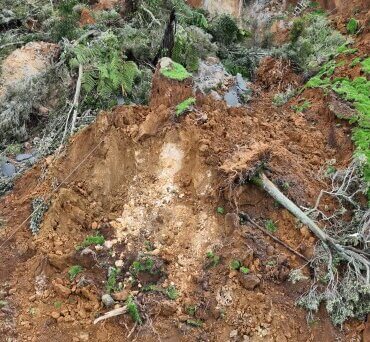
Storm damage, Kōpaki Road, Te Kuiti
Driving between Wellington and Te Awamutu last week, my geologist brain was on high alert.

Janine Krippner
I was unaware of the storm that had passed through the King Country on October 16, a few days prior, and it was quickly evident that a significant weather event had occurred. First and foremost, I hope everyone in the area is okay. I have heard of some of the losses and my heart goes out to you.
As a geologist and volcanologist, I am quick to notice rockfalls and landslides along the roadside. My eyes are drawn to the clues scattered across our landscape, signs that tell stories of how it formed and how it continues to change. During this drive, I had to pull over a few times so I wouldn’t be distracted by the sheer number of fresh landslides and rockfalls. Flooding was evident, streams had overtopped and eroded their banks and there was debris from water crossing the road in several places.
I was impressed, though, at how quickly debris had been cleared from the main road. A huge thank you to everyone involved in that work.

Storm damage, Waiharakeke Bridge
It’s no secret that much of Aotearoa is prone to landslides, or “mass wasting”- the downslope movement of rock and soil. This term covers a range of materials (rock, soil, or mud) and movement types (fall, slide, flow, or creep). Some events are so small they go unnoticed, while others can be large enough to tragically bury an entire town.
Mass wasting can be triggered by different processes, including earthquakes, or in this case, a lot of rain. We can also make our landscape more prone to experiencing mass wasting, including land use changes like cutting down trees or bush, altering the landscape – such as removing the base of a slope – or altering drainage patterns. One of the most important factors that contribute to rainfall-triggered landslides is land use change.
It’s important to understand the warning signs of potential landslides. The Get Ready website has an excellent guide on what to do before, during, and after a landslide, including early warning signs that land may be starting to move. Monitoring slopes and acting on those signs, such as through timely evacuations, can save lives.
Cracks or bulges in the ground, roads, or paved areas may signal movement. If the land beneath a building begins to shift, new gaps can appear, and doors or windows may start sticking. Trees, retaining walls, and fences may begin to lean or distort.
Staying alert while driving is important, especially during or after heavy rain around our hillier landscapes.
I keep a go-bag with supplies in my car in case I am ever stuck somewhere, which I packed with landslides in mind. Small steps like this ensure that if we are ever caught out by our changing landscape, we are prepared. We are not powerless and understanding what to look out for, and what to do, can make all the difference.








